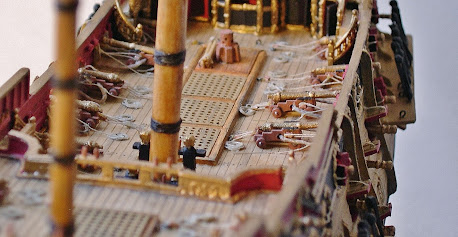This is a more advanced image of the PRINCE current stage, but it has enough finished detail to now focus on the upper batteries and channel deadeyes.
I realize that this will probably be a seven to eight part blog. However, it's worth writing, especially when serious builders want to further their skills relative to historical detail(s) as opposed to the generic -or common practice.
I can't say it enough about 'admiralty models'..Again, they were not accurate in the sense of scale, but rather beautiful art pieces that were visual prototypes for building the actual ship. Builders get caught up in thinking that these prototypes were, in essence, the 'bible' to naval architecture. They weren't; and to believe that is a misnomer. I was fortunate to learn this (the hard way) years ago when a serious collector 'collectively' corrected me on certain details that I copied from a admiralty model. He waived the advances (out of respect for my work) and had me repeat the build with written data from writings of that period. That model became the cornerstone for all my models -including steamboats.
The images I'm about to place here will stem from actual documentation -and not speculation or theory. This is what makes a model unique and beautiful.
In my last blog I showed how I customized cannon to fit properly in the ports. Here, I show them from various deck angles which give a realistic feel of duplicating the actual ship...This is due, in part, because of proper scaling. Below are four images to support this:
A port broadside overview showing the complete gun batteries in both coil and recoil positions on both the main and quarter decks.
Starboard profile of main deck artillery...
Port stern view showing partial full main and quarter deck cannons. This was the final deck installation before moving on to the channel details. On the admiralty model the belay pins were atop the rails. Unfortunately, because the Airfix version was off scale in this area, I had to compensate by placing the pinrails inside the bulwarks.
Over a hundred or so models I researched on Prince, I noticed details missing that encouraged me to place more emphasis on this. With the channels I noticed eyebolts missing which took the relieving tackles; but this was also evident in the tops. On the main channel the lower studding sail boom and cradle wasn't featured (on any of the models); nor knees attached to both channel and hull to strengthen it (channel) for taking on the heavy boom and relieving tackles. Below, I show this detail in a Willem van de Velde II study of the English ship VICTORY which was built in 1620...She is shown as she appeared in 1666.
There is another possibility at play here; the fact that this was, and could be, a spar lashed alongside in the event that a topmast was lost at sea due to inclement weather or sea battle. There is another spar at the quarter deck tier which is lashed as well. However, in the Kennington lists of the 1650s, studding booms were mentioned for the main mast and must be presumed to fit on the main channel.
For a model builder, it's a judgement call. For me, I chose to feature this detail as an additive to European maritime practice as shown in the photo image below.
Another portside overview showing the studding boom and cradle on the left at the deadeyes and channel...
Now that I've clarified the studding booms, my next process of the build are the masts.
To join plastic to wood is a tricky endeavor. The right glue is needed and a ton of patience. Since I will be using the plastic tops, caps, and crosstrees; it's essential that I carve the wood masts a millimeter smaller than the actual (plastic) masts so that these can be fitted properly in the routed cavities where the plastic was. To keep the wood in those cavities I carefully drill holes in both plastic and wood pieces -gluing a metal pin in the wood and then sliding the open air part of the pin into the plastic. Being careful not to have glue touch the exposed areas since these have to be stained, varnished and painted.
Below, I shave away excess wood to form the mast...
The next step of the build is to study all the belay systems before stepping the masts. This is very important, because once the masts are secured, there's no possibility of having all the lines rigged. This can take several weeks...sometimes a few months; and serious builders/collectors know this.
Below are several views showing the masts, and how they will appear on the model before the rigging is started.
This concludes the fourth part of the HMS Prince build. I truly hope that what I've stated can be beneficial to those who currently own the Airfix kit. Understand that no kit is a hundred percent intact by way of fitting together parts. Every kit has its pitfall, no matter how detailed.
What will guarantee a nice model will be the patience in building it. There will be moments of anxiety and frustration; but that comes with the territory of discovering new information and/or techniques. Quality depends on how much time one is willing to put in a project...but, NEVER get consumed. That will only drain your focus. The 'first' PRINCE drained my focus, as the model was attractive; but, common mistakes were made. However, I corrected those flaws and am satisfied with this current work.
That being said, I close this portion to make way for the next.
Fairwinds!















No comments:
Post a Comment